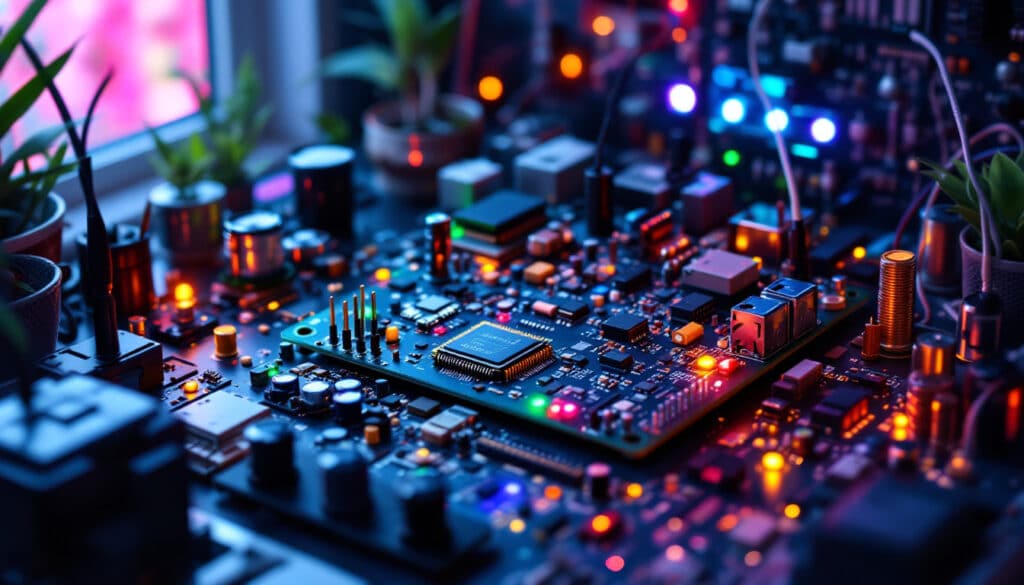Cyber-physical systems, often abbreviated as CPS, refer to systems that integrate both computational and physical elements in a collaborative network. They encompass connected devices that constantly interact with their physical environment through sensors and actuators. This integration allows for more effective and responsive control and command of various physical entities. These systems, rooted in contemporary technological evolution, are present in numerous fields such as automotive, aerospace, healthcare, and energy. As essential components of Industry 4.0, CPS offer enhanced adaptability and automation, making possible a wide range of applications from robotic surgery to the management of electricity distribution networks. By linking the physical and digital worlds, these systems pave the way for innovations that improve the responsiveness, safety, and efficiency of industrial operations.
Cyber-physical systems (CPS) are revolutionizing various sectors today such as automotive, aerospace, healthcare, and many more by seamlessly integrating computational elements into physical contexts. At the heart of this technology lies the synergy between digital and physical components that collaborate to control and direct tangible entities in varied environments. This integration allows for improvements not only in resource optimization and management but also encourages a more sophisticated interactivity with the physical world.
Unlike traditional embedded systems, which often focus on standalone devices, CPS stand out due to their design as networks of interactive computational elements that integrate and respond to physical inputs and outputs. These systems are crucial for the development of technologies like the Internet of Things (IoT) and robotics, thus forming an essential pillar of Industry 4.0 (see more about industrial automation in the era of Industry 4.0).
One of the foundations of CPS lies in their ability to provide enhanced responsiveness. This criterion is important in applications where execution speed is crucial, such as collision avoidance or air traffic control. Moreover, these systems introduce unmatched precision in tasks such as robotic surgery, where the slightest error could have serious consequences. By securing hazardous or hard-to-reach environments, CPS also enhance the safety and reliability of rescue or firefighting operations.
From an infrastructure perspective, CPS promote effective coordination and optimized resource management, as seen in positive energy buildings. Their ability to consult and share information in real-time enhances the efficiency and responsiveness of energy distribution systems, water management, or even urban traffic management. Find a comprehensive guide on Industrial IoT and its applications at Industrial IoT.
These systems do not merely enhance interaction with machines; they also augment human capabilities. Whether through personal health monitoring or optimizing urban transportation, they constantly integrate, analyze, and interpret large amounts of data. What distinguishes CPS is this dynamically balanced relationship it establishes between consistent initial design and subsequent adaptation to various operational requirements.
In conclusion, cyber-physical systems represent an innovative paradigm shift in how digital and physical technologies intertwine to meet modern demands. However, their implementation requires constant attention to overcome technical and organizational challenges, such as those outlined in this guide on Industry 4.0.
Table des matières
ToggleFAQ on Cyber-Physical Systems: A Definition
Q : What is a cyber-physical system (CPS)?
A : A cyber-physical system (CPS) is a set of computational elements that collaborate for the control and command of physical entities. It differs from traditional embedded systems by its network of interactive elements, closely linking computational and physical components.
Q : In which fields are cyber-physical systems used?
A : Cyber-physical systems are applicable in various fields, including automotive, aerospace, chemical processes, energy, healthcare, civil infrastructure, manufacturing, transportation, entertainment, and household appliances.
Q : What are the main characteristics of CPS?
A : Cyber-physical systems are characterized by their integration of electronics, computing, metrology, automation, data fusion, and mechanics, with each field contributing to their responsiveness, precision, adaptability, efficiency, and safety.
Q : How are CPS related to Industry 4.0?
A : Cyber-physical systems are one of the two pillars of Industry 4.0, identified as priorities by organizations such as the National Science Foundation, as they enable advanced interaction between the physical and digital worlds.
Q : How can CPS be modeled?
A : The modeling of cyber-physical systems is often conducted through model-driven engineering approaches, using various methods to separate functional specifications from implementation specifications, as in the “Model Driven Architecture” (MDA) model.





